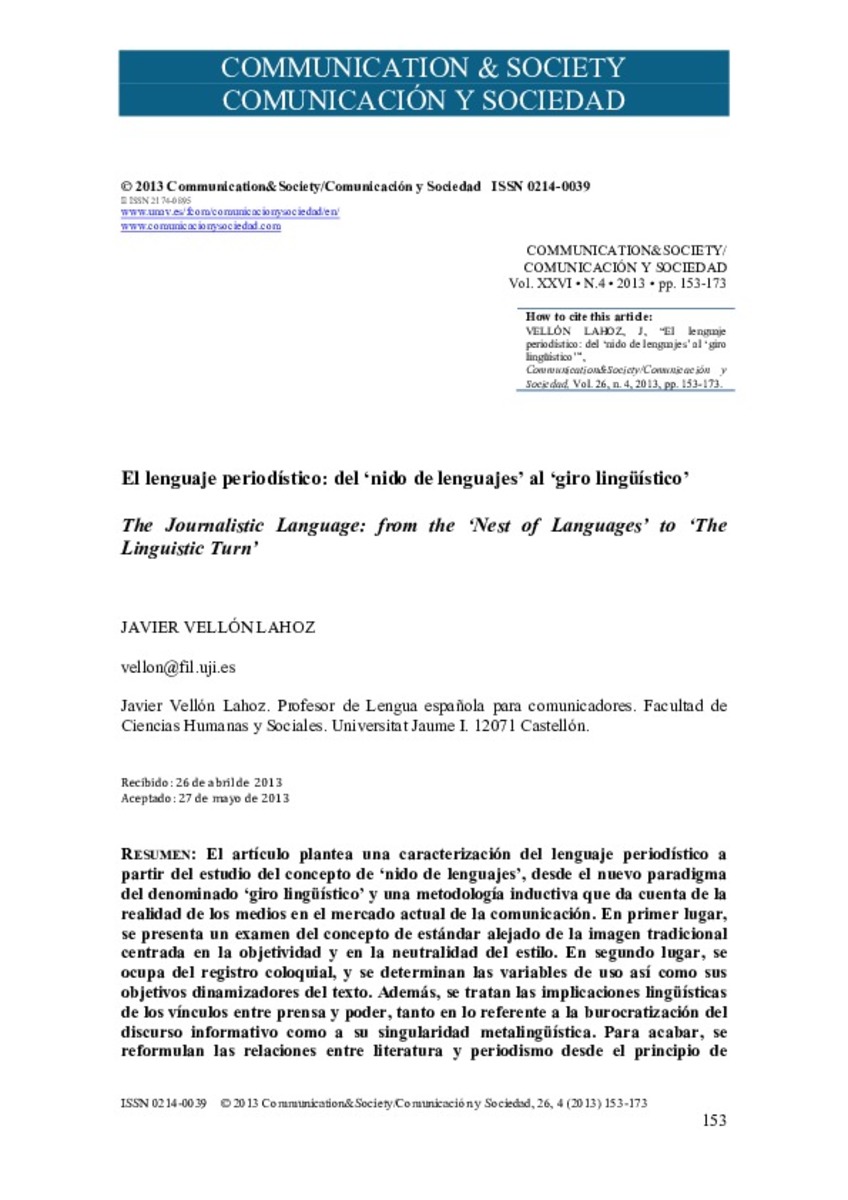Full metadata record
| DC Field | Value | Language |
|---|---|---|
| dc.creator | Vellón-Lahoz, J. (Javier) | - |
| dc.date.accessioned | 2014-03-20T13:40:23Z | - |
| dc.date.available | 2014-03-20T13:40:23Z | - |
| dc.date.issued | 2013 | - |
| dc.identifier.citation | VELLÓN LAHOZ, J, “El lenguaje periodístico: del ‘nido de lenguajes’ al ‘giro lingüístico’”, Communication&Society/Comunicación y Sociedad, Vol. 26, n. 4, 2013, pp. 153-173. | es_ES |
| dc.identifier.issn | 2174-0895 | - |
| dc.identifier.uri | https://hdl.handle.net/10171/35566 | - |
| dc.description.abstract | El artículo plantea una caracterización del lenguaje periodístico a partir del estudio del concepto de ‘nido de lenguajes’, desde el nuevo paradigma del denominado ‘giro lingüístico’ y una metodología inductiva que da cuenta de la realidad de los medios en el mercado actual de la comunicación. En primer lugar, se presenta un examen del concepto de estándar alejado de la imagen tradicional centrada en la objetividad y en la neutralidad del estilo. En segundo lugar, se ocupa del registro coloquial, y se determinan las variables de uso así como sus objetivos dinamizadores del texto. Además, se tratan las implicaciones lingüísticas de los vínculos entre prensa y poder, tanto en lo referente a la burocratización del discurso informativo como a su singularidad metalingüística. Para acabar, se reformulan las relaciones entre literatura y periodismo desde el principio de selección estilística en virtud de las necesidades expresivas para la representar la realidad desde el discurso. ----------------------------------------------------------------------- The article raises a characterization of the journalistic language from the review of the notion of 'nest of languages', following the new paradigm of the called 'linguistic turn' and an inductive methodology that gives account of the reality of the means on the current market of communication. First, one presents an interpretation of the concept of standard which is far away from the traditional vision, focused on the objectivity and on the neutralization of the style. Secondly, it deals with the colloquial register, determining the variables of use as well as its revitalizing aims of the text. Later, one treats the linguistic implications of the relationship between press and power, regarding both the bureaucratization of the informative speech and its metalinguistic singularity. Finally, the links between literature and journalism are re- formulated from the principle of stylistic selection depending on the expressive needs for the discursive representation of reality. | es_ES |
| dc.language.iso | spa | es_ES |
| dc.publisher | Servicio de Publicaciones de la Universidad de Navarra | es_ES |
| dc.rights | info:eu-repo/semantics/openAccess | es_ES |
| dc.rights | info:eu-repo/semantics/openAccess | es_ES |
| dc.subject | Lenguaje periodístico | es_ES |
| dc.subject | Variedad estándar | es_ES |
| dc.subject | Registro coloquial | es_ES |
| dc.subject | Literatura y periodismo | es_ES |
| dc.subject | El poder y la prensa | es_ES |
| dc.subject | Journalistic language | es_ES |
| dc.subject | Standard variety | es_ES |
| dc.subject | Colloquial register | es_ES |
| dc.subject | Literature and journalism | es_ES |
| dc.subject | The power and the press | es_ES |
| dc.title | El lenguaje periodístico: del ‘nido de lenguajes’ al ‘giro lingüístico’ | es_ES |
| dc.title.alternative | The Journalistic Language: from the ‘Nest of Languages’ to ‘The Linguistic Turn’ | es_ES |
| dc.type | info:eu-repo/semantics/article | es_ES |
| dc.identifier.doi | 10.15581/003.26.36064 | es_ES |
Files in This Item:
Statistics and impact
Items in Dadun are protected by copyright, with all rights reserved, unless otherwise indicated.






